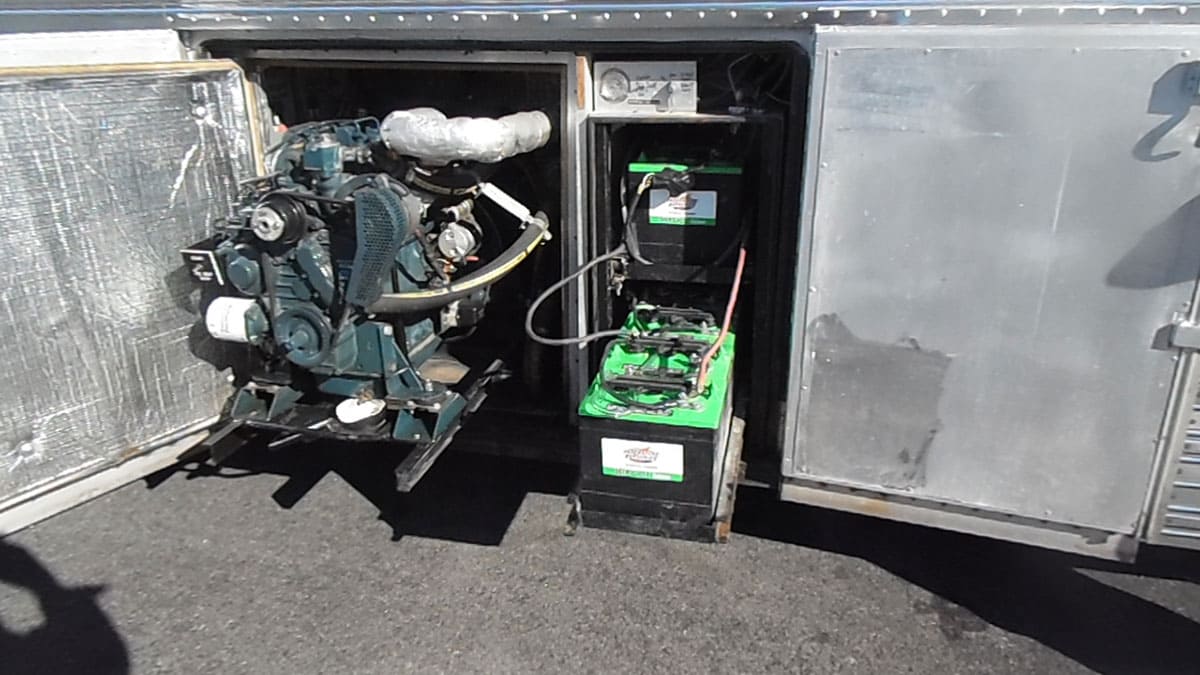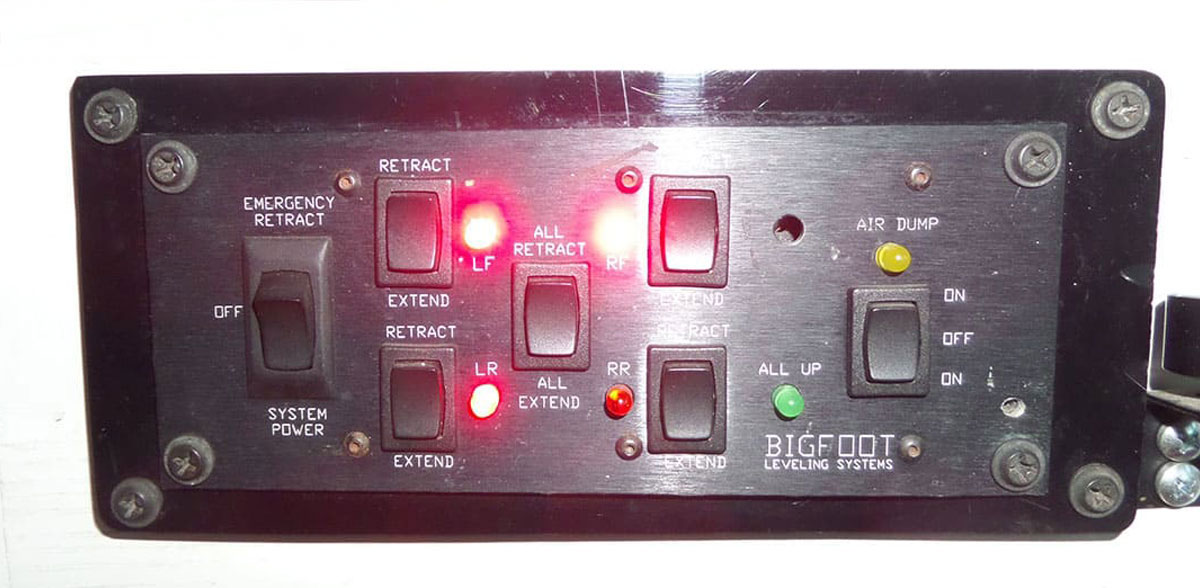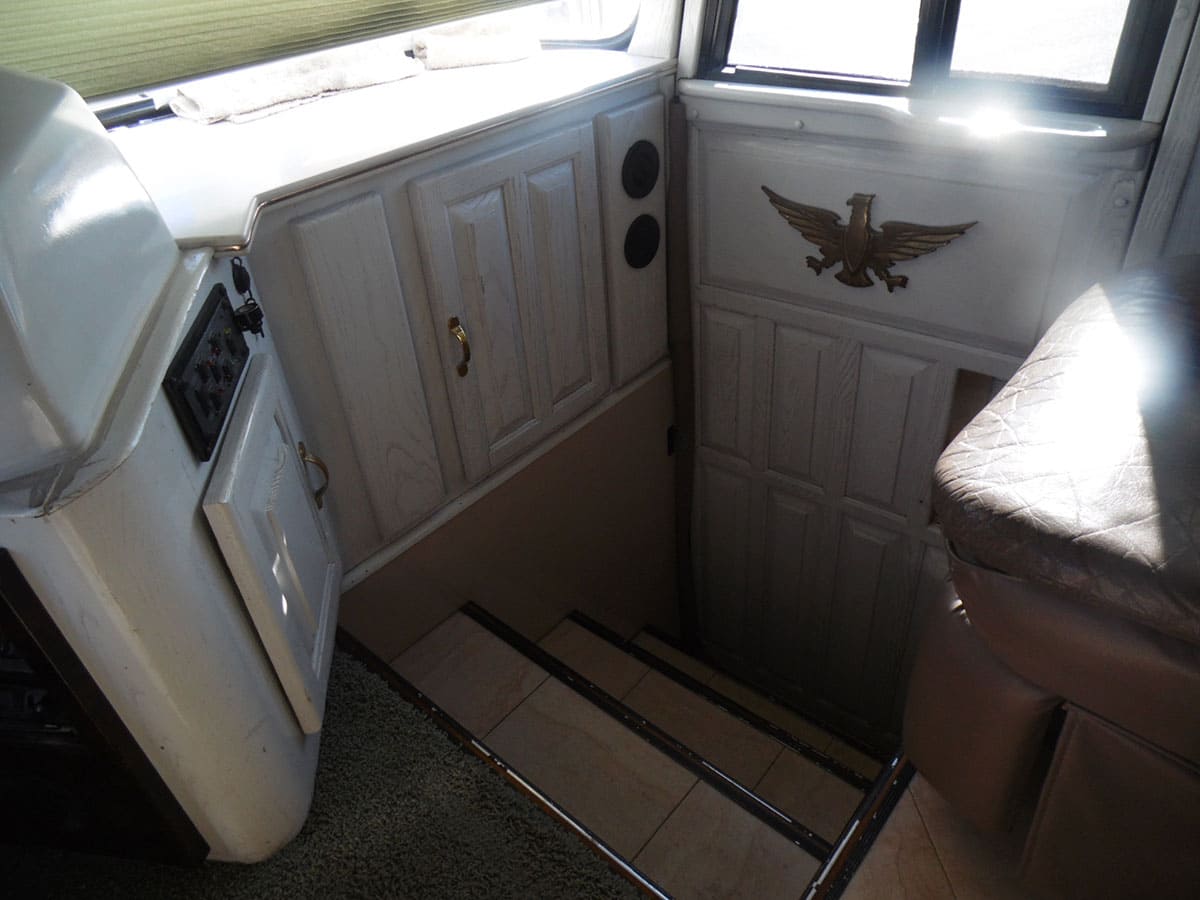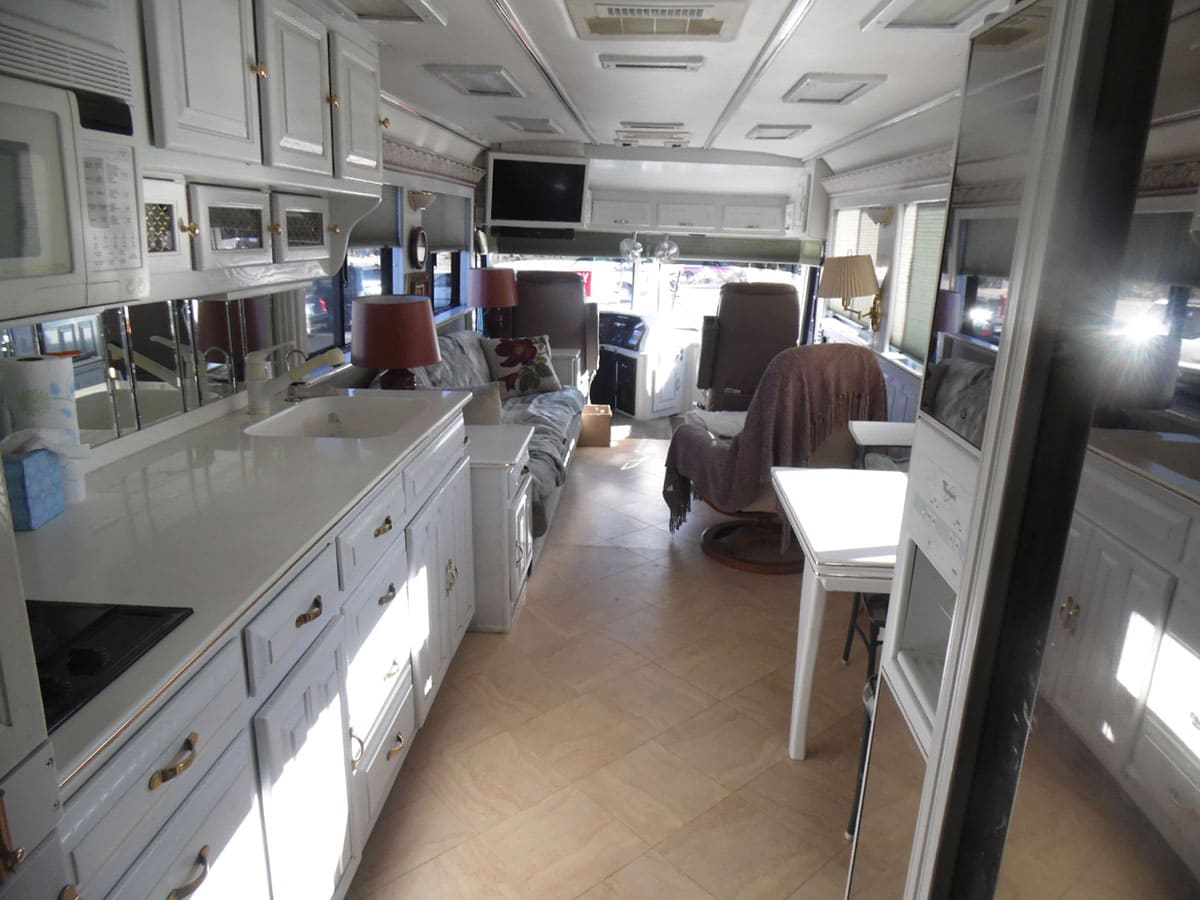No products in the cart.

Les McGinnis
April 4, 2025
178 views
The Bus of my Dreams - A 1969 Eagle 07
Les just bought his 1969 07 Eagle. Four days later, while driving it home, the motor shut down, and he was unable to drive it. He was on the freeway, having just come out of Kentucky and entered Tennessee, just five miles outside of Knoxville. Les had his bus towed to a local Volvo dealer. However, they couldn't determine what was wrong with it without tearing it down. They suggested that he have it hauled to another shop that specializes in Detroit Diesel engines.
Publisher’s Note: This is a walk-through interview with Les McGinnis, a 1969 07 Eagle bus owner, which was professionally converted in 1998. Les McGinnis showed me all of its features, which are numerous. This is an excellent example of what can be done in a bus conversion to make it almost like home. This bus has several hidden features which would not be obvious except to the owner. Here is his account of his converted Eagle bus.
When he arrived at the next shop, they slid the motor out from the back, and after three days, they called and gave him the bad news, "This motor is never going to run again." Water had gotten into the number four cylinder, and it seized up.
Rather than having the engine rebuilt, Les decided to buy a brand-new 8V92-TA military engine. At the time, Detroit Diesel would not guarantee a new or rebuilt engine, so he decided a brand-new engine would be less prone to failure. It took a month for the replacement, but now he has a brand-new engine. Replacing the engine would take less time than tearing it down, waiting for new parts to arrive, and rebuilding it. Thankfully, the previous owner covered half of the engine and installation costs, which totaled $42,000.
We began the interview by walking around his Eagle coach as Les described its features.
There are four 140W solar panels on the roof, totaling 560W of power. Each with an 18A output keeps the batteries fully charged on a sunny day. The batteries read up to 13.4V to 13.5V on a sunny day, which is pretty good for an all-electric coach.
As we move down the driver's side to the first compartment, there is a Wrico, 4-cylinder, 15kW Kubota diesel generator. It slides out, allowing for easy oil changes and unit servicing. It is located in a soundproof compartment and features a large squirrel-cage fan to remove heat from the compartment. It has a low oil shut-off switch that automatically shuts down the engine if the oil pressure becomes too low. Also, note the Engine Heat Protection ceramic insulation wrap around the exhaust system, which helps dissipate heat from the compartment through the exhaust pipe.

Wrico Generator and Coach Start Batteries.
You can start and stop the generator by a switch on the dashboard in the cockpit, and there are also gauges that allow you to view the oil pressure and temperature of the generator while driving.
The generator is also equipped with an auto-start unit that starts the generator when the voltage drops below a preset level, such as 12.1V, as I have mine set to. However, Les has never installed this feature, as he has not yet needed it. However, it is an excellent feature if you have pets in the rig and are away for part of the day, as the auto-start unit will automatically start the generator when the voltage drops to a predetermined level, allowing the air conditioning or heat to run.
Publishers Note: You can also control the heat and air conditioning from a smartphone from anywhere in the world, provided you have internet access on board. However, this bus is not equipped with that feature.
Les said he starts his generator when he determines his solar panels are not producing enough power to keep his batteries charged. In the morning, he typically runs his generator for an hour while making coffee and eating breakfast, and he may also run for an hour in the evening while cooking dinner. But, during the day, the solar panels will take care of everything in this coach, including the microwave and refrigerator, which is a double-door household refrigerator/freezer with an ice maker.
Les noted, the problem with automatic ice makers is that when you travel down the road, water can spill out, causing water to run down onto the floor. If you have one, add to your pre-flight checklist to turn it off before traveling, or better yet, wire it up to your ignition switch so that when the engine is running, it shuts off automatically.
It has an Aqua-Hot hydronic heating system that operates on both electricity and diesel. It heats both the water and the air in the coach. It has three heating zones, allowing for different temperature control in each area. One zone is designated for the bedroom area, one for the living area, and one is for the water bay compartment in the basement, which protects the pipes or tanks from freezing in cold weather.
One bay has a full-width through Joey Bed, which slides out on either side to easily access supplies.

Joey Bed - Streetside.

Joey Bed - Curbside.
Two Docking lights are on each side of the bus, which are controlled by switches on the dashboard. They come in handy when backing into a parking space at night. This is a popular feature on high-end coaches.

Docking Lights – Two per side.
The next bay, located on the streetside, contains the high-voltage circuit breaker panel and the main power breaker switch. There is also a transfer switch that connects the electric panel to either shore power or the generator, depending on whichever is providing power at the time.


Trace 2500W Inverter.
There are 110V outlets in every bay for convenience, allowing him to run power tools or other equipment whenever needed.
The water bay features a black water flush system. It also has clear tubing that allows for a visual check of the levels in each tank, including the black water tank, the grey water tank, and the freshwater tank. He has a macerator pump for the sewer, equipped with a 21-foot hose for pumping out the tanks, even if he has to pump the waste uphill.

Fresh water tank in a ¾” plywood box with Sight Gauges.
No water can be added to this coach without first passing through a freshwater filtration system, as shown here to ensure all water is safe to drink.

Plumbing Bay with Macerator Pump to empty his tanks. Filter system always provides clean water.
The freshwater tank holds 130 gallons. The black water tank holds 100 gallons, and the gray tank holds 65 gallons. The Aqua-hot heating prevents anything from freezing in cold temperatures.
An air compressor is located under the grey water tank, which lifts the bed platform to access the storage compartment under the bed and to inflate the Select Comfort air mattress. An air cylinder lift system that raises the platform to access the storage area underneath.

Raised Select Comfort mattress platform
This bus has a radiator misting system that can be operated from the driver's seat, allowing for a light spray mist to be applied on the radiator fins when it becomes too hot, such as when climbing long, steep grades. It has a micro pump that directs water from the freshwater tank onto the radiator. Once it is turned on, you can set the temperature, and it automatically sprays over the radiator fins when the engine coolant temperature reaches a pre-set limit. You can watch the engine temperature drop as you are climbing the hill.
In the engine compartment is a new 455 HP 8V92 TA engine. It features Engine Heat Protection insulation over the turbo and exhaust, designed to contain the heat and prevent it from reaching the bedroom area, instead, directing it out through the exhaust pipe. The fresh air for the engine comes through a large air filter. Les changes the air filter each year in the spring, and he records the date on the filter itself and in his log book, where he keeps all records for the engine.

Large Air Filter feeding Turbo Intake.
The VIN is located in the right-hand corner of the engine compartment. The VIN is 2031, and everyone tells Les, it can't be a VIN as it is too short, but that's what it is, as many Eagle owners know.
This coach features four Big Foot leveling jacks, allowing the bus to be leveled almost anywhere. The entire bus can also be lifted up for changing tires, if necessary. Big Foot jacks are a great feature for any bus.

Two of four Big Foot Leveling Jacks.

As noted before, this bus has an Aqua-Hot electric/diesel hydronic heating system, which heats both the air in the coach and the water for all faucets. When plugged into shore power or when the generator is running, the Aqua-Hot system can be powered by electricity, keeping the water hot and the interior of the coach warm, in mild outside temperatures. When running on diesel, it will keep everything warm, even in the coldest climates, and will even heat the bay where the water tanks and piping are located to prevent them from freezing.
This bus has a Girard automatic awning with a wind sensor on the roof. You can set it to retract automatically when the wind speed reaches between 5 MPH and 33 MPH. The awning is sixteen feet long, extending ten feet out from the bus.

Girard Automatic Awning.
Additionally, this bus features a Fantastic Fan vent in the bathroom, with a cover on the roof, allowing you to leave it open even when it's raining or you're driving, preventing dirt and rain from entering. It can be set to automatically open when it reaches a preset temperature and automatically closes when it senses rain.
There are three air conditioners on the roof, each with a built-in heating element. They are each 15,000 BTU units controlled by thermostats mounted on the wall. The air conditioners are the highest point of the bus. With the A/C units, the bus height is 12 feet 6 inches.
Les once removed all the air vents and A/C covers, which are made of fiberglass, added another layer of fiberglass material inside them to reinforce them, and reinstalled them. From the factory, they are thin and flimsy, and after a few years, the sun and wind take their toll, eventually causing them to blow away when driving down the road, potentially causing them to hit a car, damaging any car near the bus.
The bus features dual-pane, sliding tinted Peninsula windows with screens and locks. Each has day and night shades; once they come down, you can't see in or out. If you are worried about a peeping Tom, he has to be eight feet tall to reach the bottom of the windows. LOL!
On the right back corner of the living area, there is a picture. At the bottom, it states, "Built by South Western Coaches”. Built in Missouri.”
This bus has square headlights and upgraded front and rear caps. It has Ramco Mirrors that are all adjustable from the cockpit. The fisheye lens is also adjustable from the inside.
When you enter the bus, you will find tile steps with LED lighting that illuminate when the entrance door opens and turn off when the door closes.
This coach has a built-in safe, which is hidden, so you have to know where it is to use it. It is so hidden and so difficult to get to that Les does not even bother using it.
The sofa makes into a queen bed if three or four people are traveling together. There are maroon lamps and brightly colored pillows at each end of the couch. There is a clock in between the two windows above the couch. The bus has Corian countertops and window sills with white and gold trim.

The sofa pulls out into a queen-size bed.
In the entrance are light switches to turn on lights for indirect lighting or to illuminate all areas of the kitchen, living room, bedrooms, and the front porch.
There is floor lighting under the bed, as well as below the kitchen and bathroom cabinets. It makes it easy to walk through this coach at night. You're not stumbling over things or stubbing your toes in the dark.
There is an electric pocket door that separates the kitchen from the bathroom, with a full-length mirror on the bathroom side.
The coach is all-electric. It has a two-burner electric stove and a carousel convection oven. It has a slide-out pantry next to it. There is an exhaust vent fan and light over the stove. The light is over where you are washing dishes if you don't want to turn on your overhead lights.
Opposite of that is the 110V large Whirlpool household refrigerator/freezer with an ice maker. It draws approximately two amps when running, and it features window latches on top, allowing you to secure the doors while driving.
There is a switch on the dash for the engine heater. When you get up in the morning when you know you'll be hitting the road, while making coffee, you can turn on the engine heater. By the time you finish making coffee and have had breakfast, it takes you roughly 20-30 minutes. You can shut off the engine heater, turn the ignition key, and the engine will start running. This engine doesn't crank; it just fires right up.
As you proceed back on the Driver's side you come to the bath area, which is the shower. It's all made of clear glass, trimmed in gold, with a gold line running through it.

The Glass Gold Trimmed Shower.
There is a cedar-lined closet to keep moths, cockroaches, and other pests out of your clothes.

Cedar-lined closet to keep the bugs out.
In the bedroom is a Select Comfort bed, which allows you to adjust the air pressure on either side individually. One thing you always want to keep an eye on is not letting it get aired up too much and then going up to high altitude because that bed becomes like sitting on a rock. There are four cabinets across the top of the bed on the driver's side. It has reading lights, allowing you to read at night. There are also lights above each of the two windows.

The Bedroom.
On the passenger side in the bedroom is a 20-inch flat-screen TV, mounted at an angle, allowing you to watch it while in bed. It un-hooks and pivots out on a piano hinge, so you can move it right to what you want to see.

20” Flat Screen Bedroom TV.
The side-by-side household refrigerator has a freezer on one side, with an icemaker and water tap. The advantage of these is that they are significantly less expensive than an RV refrigerator and, nowadays, are very energy-efficient, drawing very little power.

The large Household Refrigerator with Freezer, Ice Maker, and Water Spigot.
The kitchen table features a Corrigan countertop with a leaf that slides out. The table drops down to align with the seats, allowing it to be converted into a bed. Across from that on the curbside, is a Euro recliner with a footrest.
The cockpit seats are all leather. The driver's seat is a 6-way power seat. The passenger side is not powered, but has a footrest for added comfort during the ride. The seatback also reclines.

The Cockpit.
The stairwell has an electric floor that slides out to cover the steps. This prevents the passenger from having to hang their legs in a hole, which is very tiring on a long trip.

The floor is shown retracted to enter and exit the coach.
The entrance door features slider windows that can be opened to let in fresh air. The passenger and driver's windows are the same, slider windows with screens and locks. There are overhead adjustable fans for both driver and passenger.
Les keeps several clothespins for reminders of what needs to be retracted, removed, or put away before traveling. Marked clothespins, for example, are used when steps are out, the power cord is connected, and for any other tasks while preparing to hit the road again. When he stops for the day and sets up camp, and needs a reminder, he pulls a clothespin out and puts it on his steering wheel. When he is ready to drive to his next destination, he does whatever the clothespin reminds him to do and then returns it to the box. Some people use a pre-flight checklist, and some people use clothespins.

Clothespins for pre-flight Checklist.
In the entryway is a cupboard that provides access to the 12V fuse panel. This panel contains all the 12V fuses for the entire coach. Anything that is 12V, such as the radio, backup camera, jacks, and water pump, etc., everything ties in behind that door on the right.

Entry Stairs and 12V Electrical Panel Cabinet.
In summary, this story is the account of Les McGinnis’s 1969 Eagle coach. He said there is no other bus out there that rides like an Eagle, and he had wanted one for several years. He drove the coach for about a year and loved it. Unfortunately, by then, he was getting too old to drive and drive and properly maintain it and sold it shortly after I visited him. Someone else now owns this beautiful coach.







General
| Manufacturer | Eagle |
|---|---|
| Model | 07 |
| Year | 1969 |
| VIN | 2031 |
| Converted By | Southwestern Coach in 1998 |
| Fuel Tank Capacity | 200 Gallons Diesel |
| Engine | Detroit Diesel 8V92-TA (455 HP) |
| Transmission | Allison HT740 5-Speed |
| Overall Length | 40' |
| Overall Width | 102" |
| Overall Height | 12’ 6” |
| Raised Roof | 6” |
| All New Siding | Installed at time of Conversion |
| Solar Power | Four 140W panels. 540W Total |
| House Batteries | One 8D |
| Electrical System | 12V & 120V |
| Inverter | 2,500W Trace Inverter |
| Shore Power | 50A |
Exterior
| Slides | None |
|---|
External Equipment
| Fresh Water Tank Capacity | 130 gallons |
|---|---|
| Grey Water Tank Capacity | 100 gallons |
| Black Water Tank Capacity | 65 gallons |
| Tank Material | Plastic |
| Water Heater | Electric/Diesel Aqua-Hot Hydronic |
Internal Equipment
| Stove | 2-Burner Electric Stovetop |
|---|---|
| Microwave | Microwave Convection Oven |
| Refrigerator | Whirlpool Household Refrigerator/Freezer side-by-side with Ice Maker |
| Bathroom | Shower |
| Toilet | RV Type China Bowl |
| Air Conditioning | Three Roof Ducted Units |
| Heating | 3-Zones Electric/Diesel Aqua-Hot Hydronic |
| Flooring Material | Amtico Tile Throughout |
| Roof Ventilation | Fantastic Fan |
| Generator | 15kW Wrico Diesel with Low Voltage Auto-start |
| TV | 28” Front & 20” Bedroom Flat TVs |
| Satellite | Dish |
Gas/Propane
| Propane | None |
|---|---|
| Gas | None |
Interior
| Insulation | Spray Foam |
|---|---|
| Countertop Material | Corian |
| Bed | Queen Size Select Comfort Air Bed |
| Window Coverings | Pleated Blinds |
| Sound System | Bose |
| Satellite Dish | Winegard HD Dish |
Additional Features
| Big Foot Leveling System, Mirrored Closet Doors, Electric Pocket Door into Bathroom, CB Radio with External Speakers, AM/FM Cassette and Sirius/XM Satellite Radio, Electric Side Mirrors, Goodyear 24.5 Tires on Polished Aluminum Wheels, Girard 15’ Power Awning with Wind Sensor, Sony Backup Camera, Flex Steel Furniture, Sofa Sleeper Bed, Jake Break, Torsilastic Suspension, Digital Compass with Thermometer, Automatic Lift Bed, Fantastic Fan, Water Filtration System, Peninsula Windows, Peninsula Pass Through Joey Bed, Holding Tank Watch System, Engine Heater, Desert Mist Radiator Cooling System, Spray Foamed, Raised Driver Floor, Electric Wipers, Meticulous Records of Maintenance and Repairs |
Article written by Les McGinnis
Les McGinnis worked for the telephone company for 28 years as a lineman and installation technician, retiring as a management inspector overseeing all contractors in the western district. His dad taught him how to weld when he was eleven years old, and when he retired from the phone company, he started his own welding business. At the age of 73, he closed his business and sold all his equipment.
Les owned two 36’ Winnebago diesel pushers, one of which burned to the ground after owning it for a year and a half. He then purchased a 40-foot Monaco Dynasty with double slides. Then, after his wife passed away, he sold the Monaco and purchased a toy hauler and a dually pickup truck, which he also used for his welding business, to pull it. Later, he decided to buy another bus, which is the Eagle that he owns now.
Then, after missing out on traveling in a motorhome and always wanting a bus, he found an Eagle coach he liked and bought it, and sold his 5th wheel and truck.
To be the first to read all new articles and to read thousands of articles about conversions back to 1992, become a member of BCM.
Click HERE to become a Member now!Click on any image in this column
to open the company's website.
to open the company's website.







